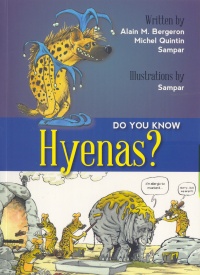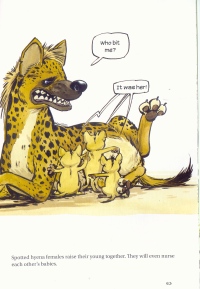| ________________
CM . . .
. Volume XXI Number 1. . . .September 5, 2014 
 |
Do You Know Hyenas? (Do You Know?).
Alain M. Bergeron, Michel Quintin & Sampar. Illustrated by Sampar. Translated by Solange Messier.
Markham, ON: Fitzhenry & Whiteside, 2014.
64 pp., pbk., $9.95.
ISBN 978-1-55455-338-9.
Grades 2-6 / Ages 7-11.
Review by Ian Stewart.
*** /4
|
| |
|

excerpt:
Hyenas emit many sounds: yelps, grunts, growls, howls, screeches and cries.
The spotted hyenaís most common cry is its energetic crazy laugh.
Spotted hyenas are rarely solitary. They usually live in clans that count from 10 to 30 hyenas, although there could be as many as 100 individuals in a group.
If there was an official animal cuddly scale, puppies would rate 100:100 and the Komodo Dragon 0:100 while hyenas might get a 17:100, and thatís only because they eat ungulate dung. The hyenas in the colourfully mocking illustrations are, believe it or not, even less charming than the skulking miscreations caricatured in the movie Lion King: sycophantic, wily and malicious. So, if the hyena is looking to improve its image in the animal kingdom, it doesnít get one in this fact-filled, snarky little volume. They are an unpleasant lot! Gross as they may be, itís still fun to learn about them in this graphic style, non-politically correct book.
 The spotted hyena is the one with which we are most familiar, but there are three species: the spotted, the brown and the striped. The brown and striped live alone or in small families and eat small animals, insects and carrion. However, the spotted is a social animal that lives in clans, with up to 100 individuals. Females dominate the clan, and the males help look after the young. Interestingly enough, we learn that the femaleís external genitalia are often mistaken for those of the males which makes for unhappy hyenas in zoo collections (p.34, p.60). The spotted hyena is the one with which we are most familiar, but there are three species: the spotted, the brown and the striped. The brown and striped live alone or in small families and eat small animals, insects and carrion. However, the spotted is a social animal that lives in clans, with up to 100 individuals. Females dominate the clan, and the males help look after the young. Interestingly enough, we learn that the femaleís external genitalia are often mistaken for those of the males which makes for unhappy hyenas in zoo collections (p.34, p.60).
Spotted hyenas are the apex scavenger of the African savanna, and a clan of hyena can devour a rotting zebra carcass in only a few minutes, leaving only hoofs and tufts of hair for the vultures. Although it may seem disgusting, scavenging plays an important role in nature by preventing the spread of disease. When the opportunity arises, spotted hyenas will hunt wildebeest, antelope, baby rhinos and old and injured elephants and lions.
Along with learning some particularly good words like ungulate, crepuscular and genitalia, students will develop an understanding of the diversity and harshness of the natural world. Itís not all puppies and kittens out there.
Recommended.
Ian Stewart teaches at Cecil Rhodes School in Winnipeg, MB.

To comment
on this title or this review, send mail to cm@umanitoba.ca.
Copyright © the Manitoba Library Association. Reproduction for personal
use is permitted only if this copyright notice is maintained. Any
other reproduction is prohibited without permission.
Next Review |
Table of Contents for This Issue
- September 5, 2014.
CM Home | Back Issues
| Search
| CM Archive
| Profiles Archive
|

 The spotted hyena is the one with which we are most familiar, but there are three species: the spotted, the brown and the striped. The brown and striped live alone or in small families and eat small animals, insects and carrion. However, the spotted is a social animal that lives in clans, with up to 100 individuals. Females dominate the clan, and the males help look after the young. Interestingly enough, we learn that the femaleís external genitalia are often mistaken for those of the males which makes for unhappy hyenas in zoo collections (p.34, p.60).
The spotted hyena is the one with which we are most familiar, but there are three species: the spotted, the brown and the striped. The brown and striped live alone or in small families and eat small animals, insects and carrion. However, the spotted is a social animal that lives in clans, with up to 100 individuals. Females dominate the clan, and the males help look after the young. Interestingly enough, we learn that the femaleís external genitalia are often mistaken for those of the males which makes for unhappy hyenas in zoo collections (p.34, p.60).